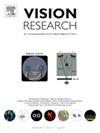Attentional misguidance from contextual learning after target location changes in natural scenes
IF 1.4
4区 心理学
Q4 NEUROSCIENCES
引用次数: 0
Abstract
Attentional orienting in complex visual environments is supported by statistical learning of regularities. For instance, visual search for a target is faster when a distractor layout is repeatedly encountered, illustrating that learned contextual invariances improve attentional guidance (contextual cueing). Although contextual learning is usually relatively efficient, relocating the target (within an otherwise unchanged layout) typically abolishes contextual cueing, while revealing only a slow recovery of learning. However, such a “lack-of-adaptation” was usually only shown with artificial displays with target/distractor letters. The current study in turn used more realistic natural scene images to determine whether a comparable cost would also be evident in real-life contexts. Two experiments compared initial contextual cueing and the subsequent updating after a change in displays that either presented artificial letters, or natural scenes as contexts. With letter displays, an initial cueing effect was found that was associated with non-explicit, incidental learning, which vanished after the change. Natural scene displays either revealed a rather large cueing effect that was related to explicit memory (Experiment 1), or cueing was less strong and based on incidental learning (Experiment 2), with the size of cueing and the explicitness of the memory representation depending on the variability of the presented scene images. However, these variable initial benefits in scene displays always led to a substantial reduction after the change, comparable to the pattern in letter displays. Together, these findings show that the “richness” of natural scene contexts does not facilitate flexible contextual updating.
自然场景中目标位置变化后情境学习引起的注意误导
在复杂的视觉环境中,注意定向是由规律的统计学习支持的。例如,当重复遇到干扰物布局时,视觉搜索目标的速度会更快,这说明习得的上下文不变性可以改善注意力引导(上下文提示)。虽然上下文学习通常相对有效,但重新定位目标(在其他未改变的布局中)通常会消除上下文线索,同时只能显示缓慢的学习恢复。然而,这种“缺乏适应”通常只在带有目标/干扰字母的人工显示中表现出来。目前的研究反过来使用了更真实的自然场景图像来确定在现实生活中是否也会出现类似的成本。两个实验比较了最初的上下文提示和在显示变化后的后续更新,这些显示要么以人工字母为背景,要么以自然场景为背景。对于字母显示,最初的提示效应与非明确的、偶然的学习有关,在改变后就消失了。自然场景显示显示出与外显记忆相关的相当大的提示效应(实验1),或者提示不那么强,基于偶然学习(实验2),提示的大小和记忆表征的明确性取决于所呈现的场景图像的可变性。然而,在场景显示中,这些可变的初始收益总是导致变化后的大幅减少,与字母显示的模式相当。总之,这些发现表明,自然场景背景的“丰富性”不利于灵活的语境更新。
本文章由计算机程序翻译,如有差异,请以英文原文为准。
求助全文
约1分钟内获得全文
求助全文
来源期刊

Vision Research
医学-神经科学
CiteScore
3.70
自引率
16.70%
发文量
111
审稿时长
66 days
期刊介绍:
Vision Research is a journal devoted to the functional aspects of human, vertebrate and invertebrate vision and publishes experimental and observational studies, reviews, and theoretical and computational analyses. Vision Research also publishes clinical studies relevant to normal visual function and basic research relevant to visual dysfunction or its clinical investigation. Functional aspects of vision is interpreted broadly, ranging from molecular and cellular function to perception and behavior. Detailed descriptions are encouraged but enough introductory background should be included for non-specialists. Theoretical and computational papers should give a sense of order to the facts or point to new verifiable observations. Papers dealing with questions in the history of vision science should stress the development of ideas in the field.
 求助内容:
求助内容: 应助结果提醒方式:
应助结果提醒方式:


